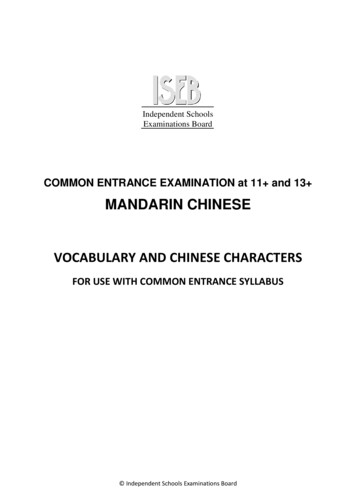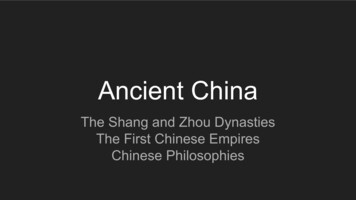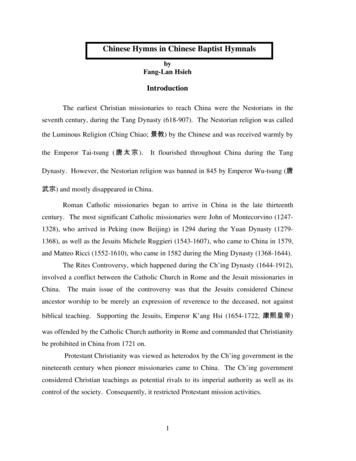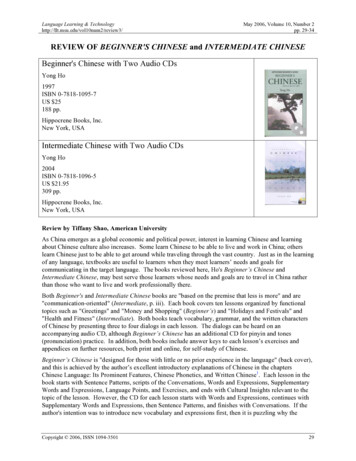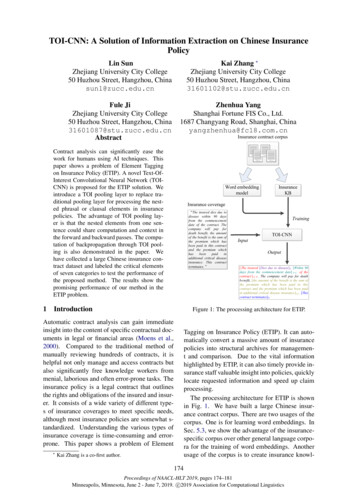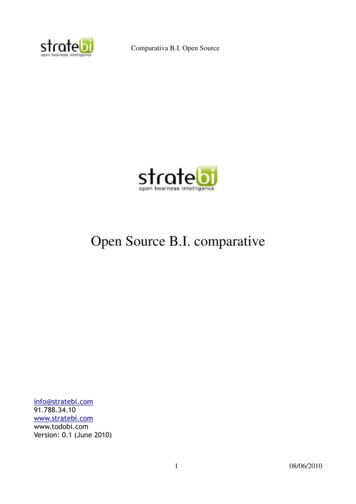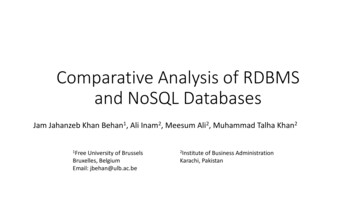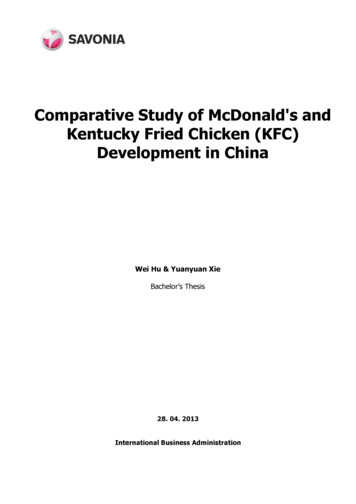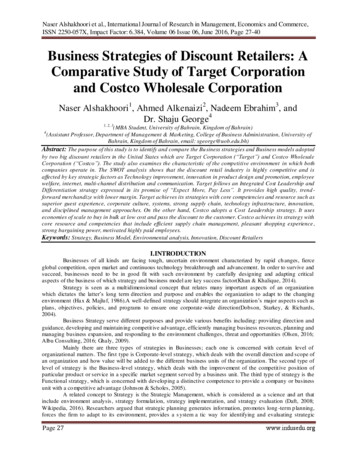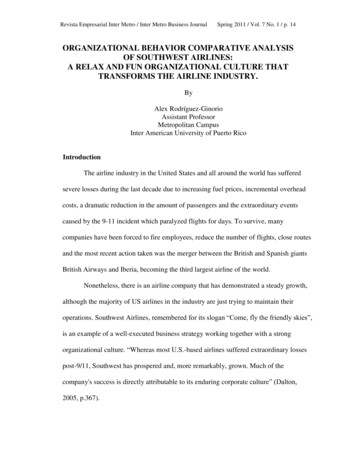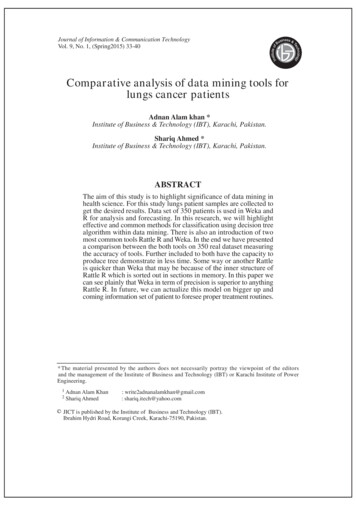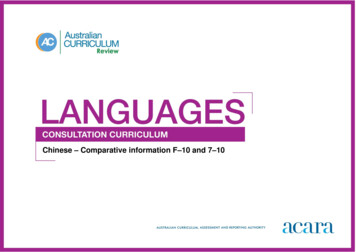
Transcription
Chinese – Comparative information F–10 and 7–10
Copyright statementThe copyright material published in this work is subject to the Copyright Act 1968 (Cth) and is owned by ACARA or, where indicated, by a party other than ACARA.This material is consultation material only and has not been endorsed by Australia’s nine education ministers.You may view, download, display, print, reproduce (such as by making photocopies) and distribute these materials in unaltered form only for your personal, noncommercial educational purposes or for the non-commercial educational purposes of your organisation, provided that you make others aware it can only be used forthese purposes and attribute ACARA as the source. For attribution details, refer to clause 5 of the Copyright and Terms of Use published on the Australian Curriculumwebsite – s-of-use.ACARA does not endorse any product that uses the Australian Curriculum Review consultation material or make any representations as to the quality of suchproducts. Any product that uses this material should not be taken to be affiliated with ACARA or have the sponsorship or approval of ACARA.2
COMPARISON OF CURRENT AND REVISED CURRICULUM IN LANGUAGES: CHINESEThe following comparative data refers to the two sequences (Foundation to Year 10 and Years 7 to 10).Content descriptions: Foundation (New)Content descriptionsProposedwith support, recognise and communicate meaning in Chinese (AC9LCF01)Proposedexplore, with support, language features of Chinese noticing similarities and differences between Chinese and English (AC9LCF02)Proposedexplore connections between language and culture (AC9LCF03)Achievement standardBy the end of the Foundation year, students use play and imagination to interact and create Chinese texts, with support. They identify that Chinese and Englishlook and sound different. They recognise that there are languages and cultures as well as their own, and that aspects of language and culture contribute to theirown and others’ cultural identity.Australian Curriculum: Languages: Chinese – Comparative information F–10 and 7–10Consultation curriculum ACARA 20211
Content descriptions Years 1 to 6StrandOriginalCommunicatingProposedCommunicating in cting in ChineseContentdescriptionsYears 1 and 2Years 3 and 4Years 5 and 6Students learn to:Students learn to:Students learn to:OriginalParticipate in class routines, structuredconversations and activities using teachermodelled tones and rhythms[Key concepts: self, family; Key processes:participating, imitating, listening](ACLCHC001)Interact with teachers and peers in social andclass activities, exchanging ideas and opinions,using correct tones[Key concepts: friendship, play, relationships;Key processes: participating, noticing,recognising, listening] (ACLCHC017)initiate interactions with peers and knownadults to plan and organise social activities[Key concepts: community, leisure, nature,recreation; Key processes: planning,organising, transacting] (ACLCHC033)OriginalInteract with simple written texts in familiarcontexts to contribute to class discussions[Key concepts: self, family; Key processes:reading, planning] (ACLCHC002)ProposedRecognise and respond to modelledclassroom-related greetings, instructionsand routines; and personal introductions(AC9LC2C01)initiate exchanges and respond to modelledquestions about self, others, and classroomenvironment, using formulaic expressions(AC9LC4C01)initiate and sustain modelled exchanges infamiliar contexts related to students’ personalworld and school environment (AC9LC6C01)Exchange simple correspondence with teachersand peers to contribute suggestions andarrange activities[Key concepts: family, friendship, exchange;Key processes: participating, noticing,Exchange correspondence and create simplewritten material to plan future activities andevents and contribute ideasOriginalAustralian Curriculum: Languages: Chinese – Comparative information F–10 and 7–10Consultation curriculum ACARA 20212
Proposedparticipate in a range of guided, play-basedlanguage activities using formulaicexpressions, visual and spoken cues(AC9LC2C02)recognising, responding, listening](ACLCHC018)[Key concepts: friendship, community,recreation; Key processes: collaborating,exchanging] (ACLCHC034)participate in activities that involve planning andtransacting with others, using a range of familiarphrases and modelled structures(AC9LC4C02)participate in activities that involve planningand negotiating with others, using languagethat expresses information, preferences andideas NewOriginalInforming; Translating; ReflectingProposedMediating in and between languagesContentdescriptionsYears 1 and 2Years 3 and 4Years 5 and 6Students learn to:Students learn to:Students learn to:OriginalLocate information about family and familiarevents from spoken and visual sources andconvey this information in simple visual andoral textsObtain and process information aboutsignificant people, places and events fromspoken and visual sources, and convey thisinformation using learnt phrases and key wordsObtain and process specific information frommultiple spoken sources, selecting andsequencing appropriate content for specificaudiencesAustralian Curriculum: Languages: Chinese – Comparative information F–10 and 7–10Consultation curriculum ACARA 20213
[Key concepts: self, family, information; Keyprocesses: describing, conveying](ACLCHC003)[Key concepts: significance, self, family,neighbourhood, environment; Key processes:participating, noticing, recognising, responding,listening] (ACLCHC019)[Key concepts: public, private; Key processes:comparing, collaborating, recording,identifying, describing] (ACLCHC035)OriginalLocate and present information aboutfamiliar objects, people and personalinterests using visual and contextual cues[Key concepts: self, family, home, routines;Key processes: obtaining, processing](ACLCHC004)Locate factual information from sources andreport this information to a known audienceusing learnt characters[Key concepts: information, topic; Keyprocesses: obtaining, processing, interpreting](ACLCHC020)Locate key points in written informative texts,summarising the points to report to knownaudiences[Key concept: information; Key processes:reading, viewing, summarising, analysing](ACLCHC036)OriginalRespond to and create simple Chinesestories, songs and rhymes, reproducingrhythm and sound patterns to expressfeelings[Key concept: imagination] (ACLCHC005)Respond to and create simple imaginative textsusing voice, rhythm, and appropriate gestureand action[Key concept: imagination; Key processes:feeling, participating, noticing, recognising,responding, listening] (ACLCHC021)Engage with characters and points of view inshort imaginative texts, express personalopinions and create simple spokenimaginative texts[Key concepts: character, viewpoint; Keyprocesses: connecting, expressing,responding] (ACLCHC037)OriginalIdentify common Chinese characters andwords in Pinyin using contextual cues[Key concepts: self, family, home, routines;Key processes: interpreting, analysing,copying, tracing, shaping] (ACLCHC008)OriginalEngage with familiar text types to predictmeaning (ACLCHU013)Proposedlocate, with support, key information infamiliar texts, and respond using gestures,images, words and formulaic phrases(AC9LC2C03)locate and respond to key information related tofamiliar content obtained from spoken, writtenand multimodal texts(AC9LC4C03)locate and process information and ideas in arange of spoken, written and multimodal texts,and respond in different ways to suit purpose(AC9LC6C03)Originalidentify equivalent or similar Chinese wordsor phrases for familiar objects or terms inEnglishTranslate the meanings of important everydaywords using contextual cuesInterpret and translate simple texts used foreveryday purposes, identifying actions, wordsAustralian Curriculum: Languages: Chinese – Comparative information F–10 and 7–10Consultation curriculum ACARA 20214
Original[Key concepts: similarity, difference; Keyprocesses: translating, connecting,interpreting] (ACLCHC007)[Key concepts: context, celebration; Keyprocesses: participating, recognising,responding, listening] (ACLCHC023)Identify the features of formal language usedin familiar contexts, such as at school(ACLCHU015)Find English equivalents of commonexpressions in Chinese and vice versa[Key concept: equivalence; Key processes:translating, explaining] (ACLCHC024)OriginalProposedand phrases that do not readily translate intoEnglish[Key concept: equivalence; Key processes:interpreting, translating] (ACLCHC039)Identify the likely contexts and features ofinformal and formal conversations involvingknown participants of different ages, gendersand social positions (ACLCHU031)notice that language carries culturalmeaning in classroom-related greetings,introductions, instructions and routines(AC9LC2C04)develop strategies to comprehend and adjustChinese language in familiar contexts to conveycultural meaning (AC9LC4C04)apply strategies to interpret and conveymeaning in Chinese language in familiarspoken, written and non-verbal culturalcontexts ing texts in ChineseContentdescriptionsYears 1 and 2Years 3 and 4Years 5 and 6Students learn to:Students learn to:Students learn to:OriginalCreate short imaginative written texts usingimages and copied charactersCreate short written imaginative texts usingsimple characters and short sentencesCreate written imaginative texts, describingcharacters and sequencing events, usingAustralian Curriculum: Languages: Chinese – Comparative information F–10 and 7–10Consultation curriculum ACARA 20215
[Key concepts: morality; Key processes:illustrating, copying] (ACLCHC006)[Key concepts: characters, events, plot; Keyprocesses: participating, noticing, recognising,responding, listening] (ACLCHC022)scaffolded models of texts, learnt characters orword lists for support[Key concepts: character, narrative, sequence;Key processes: connecting, expressing,responding] (ACLCHC038)OriginalCreate own bilingual texts such as signs,displays and posters[Key concepts: equivalence, idiom; Keyprocesses: translating, identifying, discussing](ACLCHC040)OriginalForm sentences to express details such as thetime, place and manner of an action and tosequence ideas (ACLCHU044)Proposeduse learnt words, Pinyin and characters,familiar phrases and modelled language tocreate spoken, written and multimodal texts(AC9LC2C05)create and present informative andimaginative spoken and written texts usinglearnt words and characters, Pinyin, formulaicexpressions and sentences and modelledtextual conventions (AC9LC4C05)create and present a range of spoken andwritten texts using a variety of modelledsentence structures to sequence informationand ideas, and conventions appropriate to texttype (AC9LC6C05)Originalexplore the ways in whicheveryday language use reflects culturespecific ideas, such as the influence of age,gender and social positionon language choices (ACLCHU048)Proposeddemonstrate understanding of how languagereflects culture by beginning to use words andexpressions that reflect Chinese culturalpractices and conventions (AC9LC6C06)Australian Curriculum: Languages: Chinese – Comparative information F–10 and 7–10Consultation curriculum ACARA 20216
StrandOriginalUnderstandingProposedUnderstanding language and cultureSub-strandOriginalSystems of languageProposedUnderstanding systems of languageContentdescriptionsYears 1 and 2Years 3 and 4Years 5 and 6Students learn to:Students learn to:Students learn to:OriginalReproduce the four tones and recognise howthey can change the meaning of words(ACLCHU010)Recognise the tone-syllable nature of spokenlanguage, and compare Chinese and Englishsounds (ACLCHU026)Discriminate between similar or relatedsyllables and words by listening with attentionto intonation, stress and phrasing(ACLCHU042)Proposedrecognise Pinyin represents the sounds ofChinese and imitate tones, pronunciation,rhythms and gestures (AC9LC2U01)recognise the tone-syllable nature of spokenlanguage and use appropriate pronunciation,tone and gesture (AC9LC4U01)discriminate between similar or relatedsyllables and words by listening with attentionto intonation, stress and phrasing to developfluency and pronunciation (AC9LC6U01OriginalRecognise Chinese characters as a form ofwriting and Pinyin as the spelled-out soundsof spoken Chinese (ACLCHU011)Reproduce key Chinese characters fromfamiliar contexts using stroke types andsequences, and component forms and theirarrangement (ACLCHU027)Identify how character structure, position, andcomponent sequences relate the form of acharacter to its particular sound and meaning(ACLCHU043Use nouns, adjectives and simple sentencesto record observations (ACLCHU028)Understand that Chinese is characterised bydiversity in spoken and written forms(ACLCHU046)recognise Chinese language conventions, keycharacters, grammatical structures and basicsyntax in familiar texts and contexts(AC9LC4U02)apply modelled Chinese grammaticalstructures and formulaic expressions tocompose and respond to texts usingappropriate punctuation and textualconventions (AC9LC6U02)OriginalProposedrecognise that Chinese characters are used toconstruct meaning in texts (AC9LC2U02)Australian Curriculum: Languages: Chinese – Comparative information F–10 and 7–10Consultation curriculum ACARA 20217
OriginalUnderstand that Chinese sentences have aparticular word order (ACLCHU012)Identify similarities and differences in theorganisation of simple familiar texts(ACLCHU029))OriginalProposedNotice how the features of text organisationvary according to audience and purpose(ACLCHU045)Examine how language is used to clarify roles
Chinese language in familiar contexts to convey cultural meaning (AC9LC4C04) apply strategies to interpret and convey meaning in Chinese language in familiar spoken, written and non-verbal cultural contexts (AC9LC6C04) Sub-strand Original Creating Proposed Creating texts in Chinese Content descriptions Years 1 and 2 Students learn to:
